
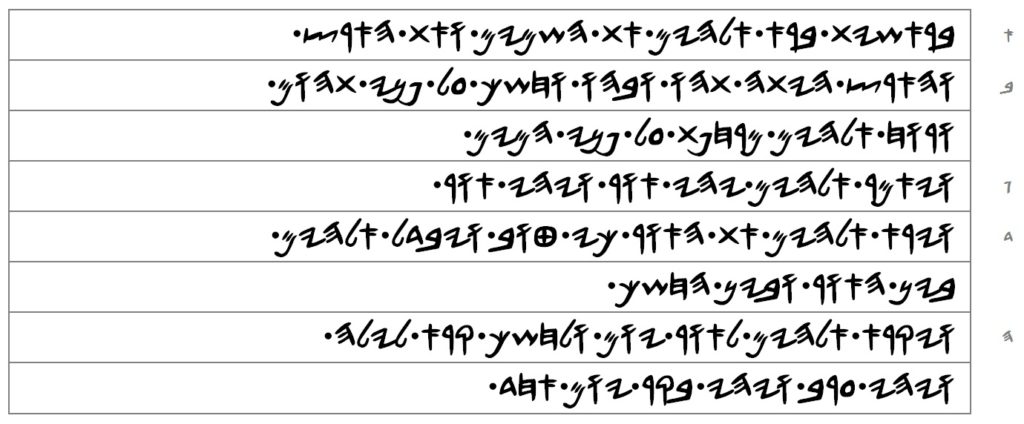
[1] ba-ra’ashayth bar’ Alah’aym ath ha-shamaym wa-ath ha-arats
In the beginning created Alah’aym the heaven and the earth.
[2] wa-ha-arats haythah thah’o wa-bah’o wa-khashach ghal panay thah’om wa-rokh Alah’aym marakhapath ghal panay ha-maym
and the earth was flat and empty, and darkness was upon the face of the abyss, and the wind of Alah’aym is hovering upon the face of the water.
[3] wA-ya’amar Alah’aym YAH’AY ‘OR wA-yah’ay ‘or
And said Alah’aym: “LET THERE BE LIGHT”. And there was light.
[4] wA-yar’ Alah’aym ath ha-‘or chay tob wA-yadabal Alah’aym bayn ha-‘or wa-bayn ha-khashach
And saw Alah’aym the light that it is good, and divided Alah’aym between the light and between the darkness.
[5] wA-yakar’ Alah’aym la-‘or YOM wa-la-khashach kar’ LAYLAH wA-yah’ay gharab wA-yah’ay bakar yom akhad
And called Alah’aym to the light DAY, and to the darkness He called NIGHT, and there was evening and there was morning: Day First.
This is another post about lokh ha-yamaym (“the table of the days,” i.e. the calendar) since the topic continues to come up and people want to see the scriptural basis for it more clearly. Hopefully this post will help.
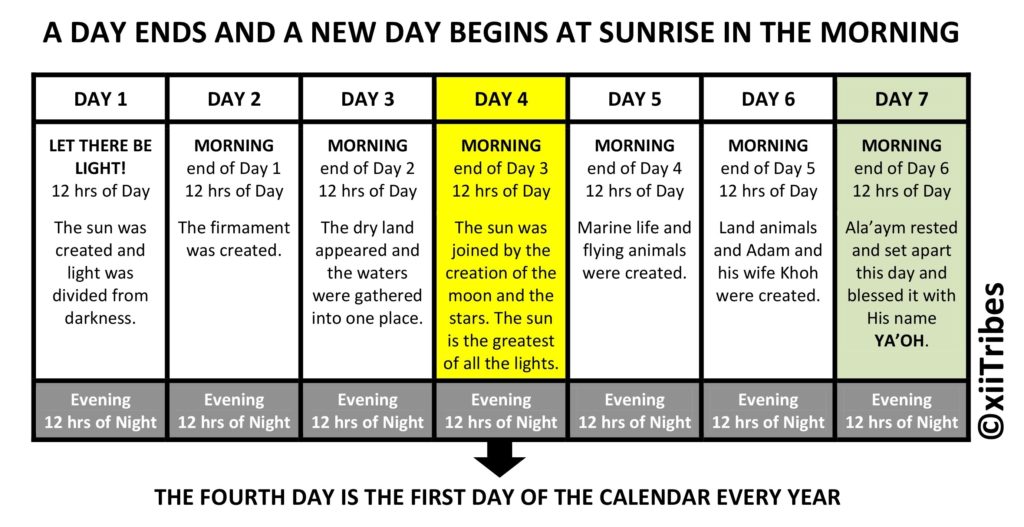
| 1 | Adam was created in Month 1, Day 3, Year 1, i.e. the sixth day of creation in the first year of the world | |
| 230 | Shath was born when his father Adam was 230 (not 130!) | |
| 435 | Anosh was born when his father Shath was 205 (not 105!) | |
| 625 | Kaynan was born when his father Anosh was 190 (not 90!) | |
| 795 | Mahlalal was born when his father Kaynan was 170 (not 70!) | |
| 960 | Yarad was born when his father Mahlalal was 165 (not 65!) | |
| 1122 | Khanoch was born when his father Yarad was 162 | |
| 1287 | Mathoshalakh was born when his father Khanoch was 165 (not 65!) | |
| 1474 | Lamach was born when his father Mathoshalakh was 187 | |
| 1656 | Nakh was born when his father Lamach was 182 | |
| 2156 | Yapath was born when his father Nakh was 500 | |
| 2168 | Sham was born when his father Nakh was 512 | |
| 2256 | THE FLOOD happened in the 600th year of Nakh’s life (2974 BCE) | |
| 2268 | Arpachshad was born to Sham 12 years (not 2 years!) after the flood | |
| 2403 | Shalakh was born when his father Arpachshad was 135 (not 35!) | |
| 2533 | Ghabar was born when his father Shalakh was 130 (not 30!) | |
| 2667 | Palag was born when his father Ghabar was 134 (not 34!) when man was scattered from the tower | |
| 2979 | Raio was born when his father Palag was 130 (not 30!) | |
| 2929 | Sharog was born when his father Raio was 132 (not 32!) | |
| 3059 | Nakhor was born when his father Sharog was 130 (not 30!) | |
| 3088 | Tharakh was born when his father Nakhor was 29 | |
| 3158 | Haran was born when his father Tharakh was 70 | |
| 3208 | Nakhor was born when his father Tharakh was 120 | |
| 3229 | Abram was born when his father Tharakh was 141 | |
| 3329 | Ya’oh-tsakhak (Isaac) was born when his father Abram was 100 | |
| 3389 | Ya’oh-ghakab (Jacob) was born when his father Ya’oh-tsakhak was 60 | |
| 3480 | Ya’ohsap (Joseph) was born when his father Ya’oh-ghakab was 91 | |
| 3652 | Mashah (Moses) was born in 349th year of the 430-year sojourn in Chanain (Canaan) and Matsraym | |
| 3732 | Mashah (age 80) demanded the release of our people from Pharaoh (1498 BCE) | |
| 3733 | THE EXODUS to the first wilderness: Month 1, Day 15 (April 30, 1497 BCE) | |
| 4212 | Shalamah (Solomon) became king in the 480th year of the Exodus (1018 BCE) | |
| 4215 | Temple foundation was laid in Year 4 of Shalamah (1015 BCE) | |
| 4252 | The united monarchy of Ya’oh-shar-al was divided by schism (978 BCE) | |
| 4641 | The Babylonian siege of Yaroshalam began in the 390th year of the schism (589/8 BCE) | |
| 4711 | The 70th year of desolations in Yaroshalam (519 BCE) | |
| 4900 | Alexander the Great conquered Persia (330 BCE) | |
| 5194 | Herod the Great (the Edomite) captured Yaroshalam (36 BCE) | |
| 5299 | The Romans destroyed Yaroshalam (70 CE) | |
| 6747 | King Charles I of Spain authorized the Trans-Atlantic Slave Trade (1518 CE) | |
| 7250 | New Year: Month 1, Day 1 (March 24, 2021 CE) | |
| 7251 | New Year: Month 1, Day 1 (March 23, 2022 CE) | |
| 7252 | THE EXODUS to the second wilderness: Month 1, Day 15 (April 5, 2023 CE) |
The heaven and the earth were created in six literal days 7,252 years ago. The current year is Year 7252 of the world and there is nothing on earth older than 7,252 years. This is what the Thorah of YA’OH and His prophets tell us by the chronological data record in the scriptures. You either believe in the validity of this data or you don’t.
The ‘or (light) created by Alah’aym in the khashach (darkness) on yom akhad (Day First) was the sun. This was the beginning of the yom (day). Do not let people confuse you when they say out of ignorance that khashach was the beginning of the day. This is a lie. The very word yom (day) is named after the light. It is utterly absurd to believe that a yom which is synonymous with the word light is the beginning of nighttime when there is no light.
The scriptures people try to use in order to promote the concept of the day beginning in the evening are Thorah 3 (Leviticus) 23:32 and Nakham-Ya’oh (Nehemiah) 13:19. Thorah 3.23:32 is only talking about an annual resting period lasting from the evening of 7/9 to the evening of 7/10. The actual yom ha-chaparaym (Day of the Atonements) begins on the morning of 7/10 because the morning is when calendar days end and begin. Nakham-Ya’oh 13:19 simply recalls how Nakham-Ya’oh prevented merchants from bringing their goods into the city of Yaroshalam to sell them to the open public on the shabath day by closing the gates of the city the night before so they could not carry their goods into the city when the shabath came in the morning. Selling goods in open public streets is strictly a daytime activity, especially back in those days when street lights did not exist.
We reckon time according to the motion of the primary luminary in heaven which is the sun. Yes the sun moves. The earth does not. When the sun appeared it was in motion. Alah’aym (the Higher Power) then divided the light so that it would only illuminate a part of the earth’s surface, while another part would be in darkness, as the sun moves. When the sun moved out of sight to the west is what the Thorah means when it states: wA-yah’ay gharab/ויהי־ערב “and there was evening”. When the sun reappeared in the east is what the Thorah means when it sates: wA-yah’ay bakar/ויהי־בקר “and there was morning”. This is what we observe with our own eyes every day. You cannot have gharab and bakar without the sun since these two terms are literally describing the sun in its motion. Since bakar was the end of yom akhad (Day First) it is also the beginning of yom shanay (Day Second). Hence the day begins in the morning. It always has.
Thorah 1.1:14-19 does not say the sun was created on yom rabay’ai’ay (Day Fourth). What happened on yom rabay’ai’ay was that the sun was joined by other luminaries in motion when Alah’aym created the moon and the stars that day and set them in motion. Prior to yom rabay’ai’ay the sun was the only luminary moving around in heaven and so there was nothing to compare it to. However, on yom rabay’ai’ay the sun was made to be the greatest light because now you could compare it with other luminaries in motion, and none of them are equal to the sun.
This implies that there is no fixed star in the sky that is actually bigger or brighter than the sun despite what you’ve been taught. The fixed stars appear to be smaller and not as bright as the sun because that is what they are according to Thorah. Our eyes are not lying to us. Someone else is. The fixed stars also cannot be light years away from earth if their light was visible to an observer on earth the same day they were created on yom rabay’ai’ay. The fixed stars are in fact closer to earth than the sun, and the sun is only 4,124 miles above earth according to real parallax. Stellar parallax is a pseudo-science.
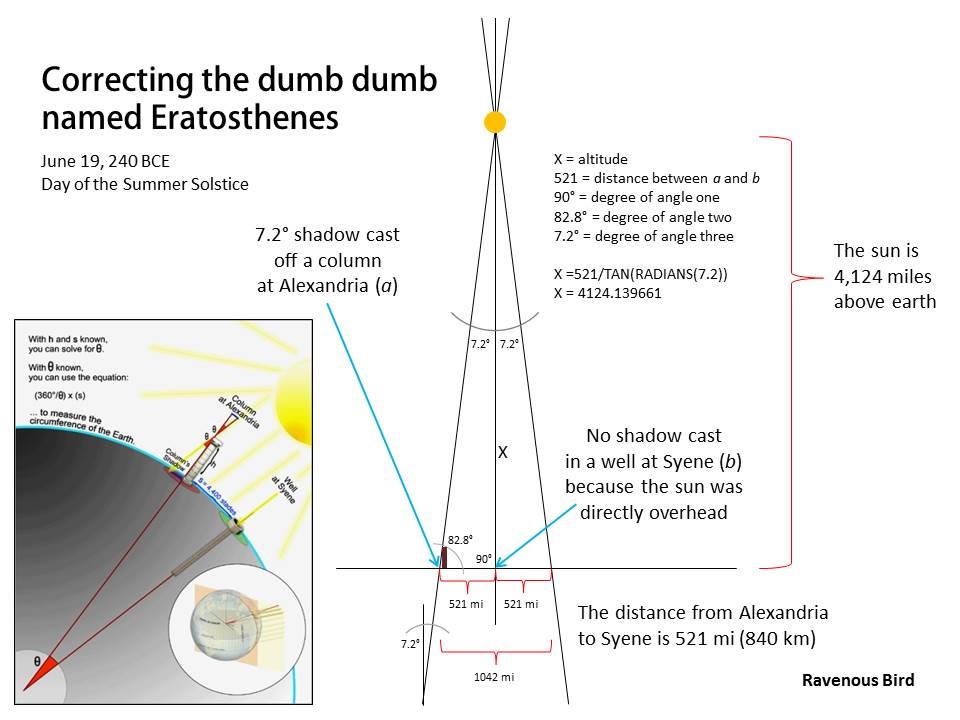
The heathen’s system of telling time is based on the premise that every day is exactly 24 hours long with no exceptions. This concept is fully ingrained into their Roman culture, a core principle of their modern technological society. At the same time, we are lied to in heathen schools that a day corresponds to one complete rotation of the earth on its axis. Unfortunately, not only are these two concepts incorrect they don’t match up — and the mismatch is more than just a few milliseconds. In fact, the mismatch amounts to several pagan minutes every day. Furthermore, because the heathen’s traditional concept of a “day” is actually defined by the cycle of sunlight and darkness — and not by one 360° rotation of the earth — the length of a real day is not consistent, but varies during the year. The heathens only pretend that all days are the same length — by averaging the length of all the days in the year, and then defining this average as a “standard day” of exactly 24 hours.
The truth is that a circle is 364° (not 360°) and in a 364°-system one complete cycle of sunlight and darkness — one day — represents a 364° revolution of the sun above the earth. Although a year consists of 365.24 days, the heathen system says that the earth rotates on its axis 366 and a quarter times during a year. From the standpoint of sunrises and sunsets, one complete spin is negated each year by the journey of the earth around the sun! This is the nonsense the heathens teach you without ever teaching you how to question it or how to challenge it.
Of course, the cycle of seasons on earth is not due to an imaginary tilt of the earth’s axis, nor the imaginary 93 million miles of distance from the sun. The main factor affecting the intensity of sunlight is simply how high the sun appears to be above the horizon, which is actually its distance from you, and this distance varies as the sun migrates north and south of the equator during its annual revolution above earth. When the sun is low in the sky, the rays strike the earth at an oblique angle, spreading the energy over a large area, thereby decreasing the intensity. If the sun were really 93 million miles away then all sunrays would strike earth parallel, but they do not do this, and this fact is what led to the flawed assumption of Eratosthenes’ ball earth theory. The sun is actually very close and its rays can strike earth at an angle as a result. The sunlight is much more intense at noon than it is in the early morning or late afternoon because of the angle of the sun’s rays at those times and not because earth is curving away from the sun or curving towards the sun as it rotates.
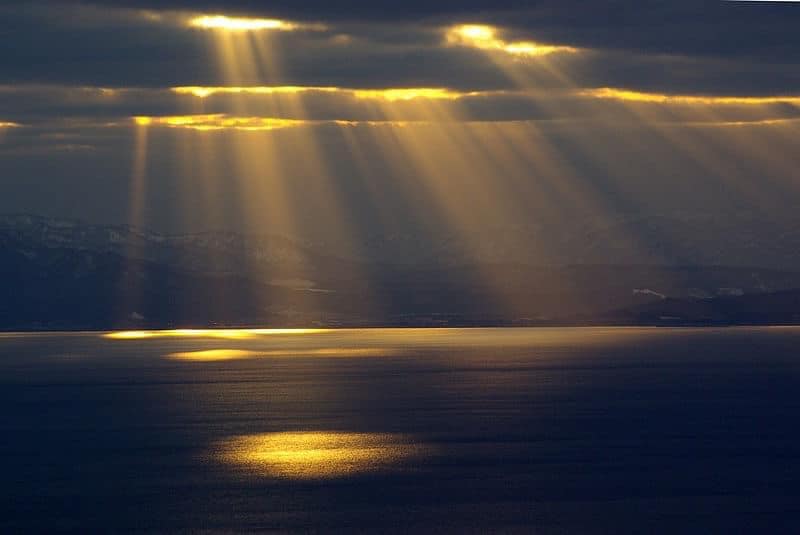
Basic geometry proves that angled sunrays mean the sun cannot be millions of miles away.
The ideal yom (day) is when the duration of daylight and nighttime are both equal. This happens during the spring and autumn equiluxes. Since the spring is when life begins anew and things begin to grow, and the autumn is when things begin to die, the yom akhad (Day One) of Thorah 1.1:1-5 was evidently the very first spring equilux. This is why the biblical calendar begins in the spring (Thorah 2.12:1-3), i.e. because the very first day in history did.
However, yom akhad is not the beginning of the new year. The creation of the additional luminaries in motion on yom rabay’ai’ay is when the lokh ha-yamaym (table of the days), i.e. the calendar year began. That is the day when the luminaries became signs for seasons and years (Thorah 1.1:14). Thus, the calendar year always starts on the morning of yom rabay’ai’ay every single year. The pagan name for this day is Wednesday. That’s what the heathens call it. We, on the other hand, do not call it that. Our days are called by numeric adjectives. They do not have proper names, especially not the proper names of pagan gods. Our days are grouped into units of seven which is called a shabo’ai/שבוע (week):
yom akhad (Day First)
yom shanay (Day Second)
yom shalayshay (Day Third)
yom rabay’ai’ay (Day Fourth)
yom khamayshay (Day Fifth)
yom shashay (Day Sixth)
yom shabay’ai’ay (Day Seventh)
Proof that what the heathens are now calling Saturday out of ignorance corresponds in part to our yom shabay’ai’ay can be found by reading Frontius, Stratagems 2.1.17. The Romans attacked our people on Saturn’s day (Saturni die) because it is our weekly day of rest, and they knew we would be vulnerable on this day. I say “corresponds in part” because the pagan Roman day begins at midnight. In other words, Saturday begins at midnight, but for us this is still the evening of yom shashay (Day Sixth). Our yom shabay’ai’ay (Day Seventh) does not begin until Saturday morning. It also includes part of Sunday because yom shabay’ai’ay does not end until Sunday morning. In reality, our yom (day) is straddling parts of two pagan Roman days because the Romans decided that a day should start in the middle of the night, which is absolutely ridiculous.
It is crucial that you understand that the months of our set apart biblical calendar year have nothing to do with the moon up in the sky regardless of what you’ve been told all your lives. Our set apart months are schematic months which track the sun’s motion not the moon’s motion. The heathens are telling you that the Ghabaray word khadash/חדש (mispronounced “chodesh” by Jews) means “new moon” in all of their translations of the bible into heathen tongues. This is incorrect. The biblical Ghabaray word for moon is yarakh not khadash. The latter word means the first day of a new calendar month, but know that a calendar month can have no association with the moon at all, just like the months of the Gregorian calendar are completely divorced from the phases of the moon. Let’s prove this to be true for the set apart months.
According to what we just went over from Thorah 1 (Genesis), the new year always begins on the morning of yom rabay’ai’ay (so-called Wednesday). This is also the first day of the first month of the calendar year. Our ancestors marched out of Old Matsraym on their Exodus in the morning of the 15th day of the first month after keeping the pasakh (passover) during the evening of the 14th day of the first month (Thorah 2.12:22; Thorah 4.33:3). Since the first month began on a yom rabay’ai’ay (Day Fourth) the 15th day of the first month is also a yom rabay’ai’ay (Day Fourth) because its fourteen days later.

The people arrived at the wilderness of Sayn (Sin) on the 15th day of the second month (Thorah 2.16:1). Then the whole congregation complained because there was no food (Thorah 2.16:2-3). YA’OH instructed Mashah to tell the people He was going to give them bread from heaven to eat, and to gather a certain amount each day, and on the sixth day to gather twice as much (Thorah 2.16:4-5). Then that same evening on the 15th day of the second month Mashah and Ahran his brother told the congregation that they would know YA’OH brought them out of Matsraym and in the morning they would see the glory of YA’OH (Thorah 2.16:6-9). As they were speaking to the congregation the glory of YA’OH appeared in the cloud, signifying that the morning of the 16th day of the second month had begun (Thorah 2.16:10). The cloud pillar only appeared in the daytime (Thorah 2.13:21-22). Then that evening of the 16th day of the second month is when quails covered the camp and the people ate meat. In the morning of the 17th day of second month is when the ground was covered with manna (Thorah 2.16:13-15).
The people were instructed to gather the manna for six consecutive mornings beginning on the morning of the 17th day of the second month (Thorah 2.16:16-21). On the sixth morning, which was the 22nd day of the second month, the people gathered twice the amount of manna as they did the previous five mornings (Thorah 2.16:22). The following morning was the beginning of yom shabay’ai’ay (Day Seventh) and the people were commanded not to gather any manna on that day (Thorah 2.16:23-26). This was the 23rd day of the second month.
This dated episode from our history as recorded by Mashah in Thorah 2.16 allows us to establish four things about our set apart calendar with certainty: (1) the day begins in the morning; (2) that the first month of the calendar year beginning on the morning of yom rabay’ai’ay (Day Fourth) of the seven-day week is always 30 days long and always ends its 30th day with yom khamayshay (Day Fifth) of the seven-day week; (3) that the second month of the calendar year always begins on yom shashay (Day Sixth) of the seven-day week; and (4) that the shabath day of rest which is yom shabay’ai’ay (Day Seventh) of the seven-day week will always fall on the 23rd day of the second month.
After this the children of Ya’oh-shar-al arrived at the wilderness of Saynay (Sinai) in the third month of the calendar year (Thorah 2.19:1). The day of the month is not stated because it was the beginning of the third month. The same method of ellipsis dating is used in 2 Chronicles 29:3 where the first day of the first month is implied without stating explicitly it was the first day of the month until we read 2 Chronicles 29:17. Mashah was instructed on the first day of the third month to tell the people to prepare for yom shalayshay (Day Third) in three days time because YA’OH would come down in person upon mount Saynay in the eyes of all the people on yom shalayshay (Thorah 2.19:11, 15).
We are now able to prove three more things about our set apart calendar: (1) that the second month of the calendar year is always 30 days long and ends its 30th day with yom shabay’ai’ay (Day Seventh) of the seven-day week; (2) that the third month of the calendar year begins on the morning of yom akhad (Day First) of the seven-day week; and (3) that the third day of the third month is always yom shalayshay (Day Third) of the seven-day week.
There is only ONE calendar where it is possible for the first days of the months to always fall on the same days of the seven-day week each year, and also where the first and the second months of the calendar year are both 30 days long, and that is a schematic calendar of 364 days. In this calendar, the third month, the sixth month, the ninth month, and the twelfth month are 31 days long. The other eight months of the calendar are always 30 days long (see below).
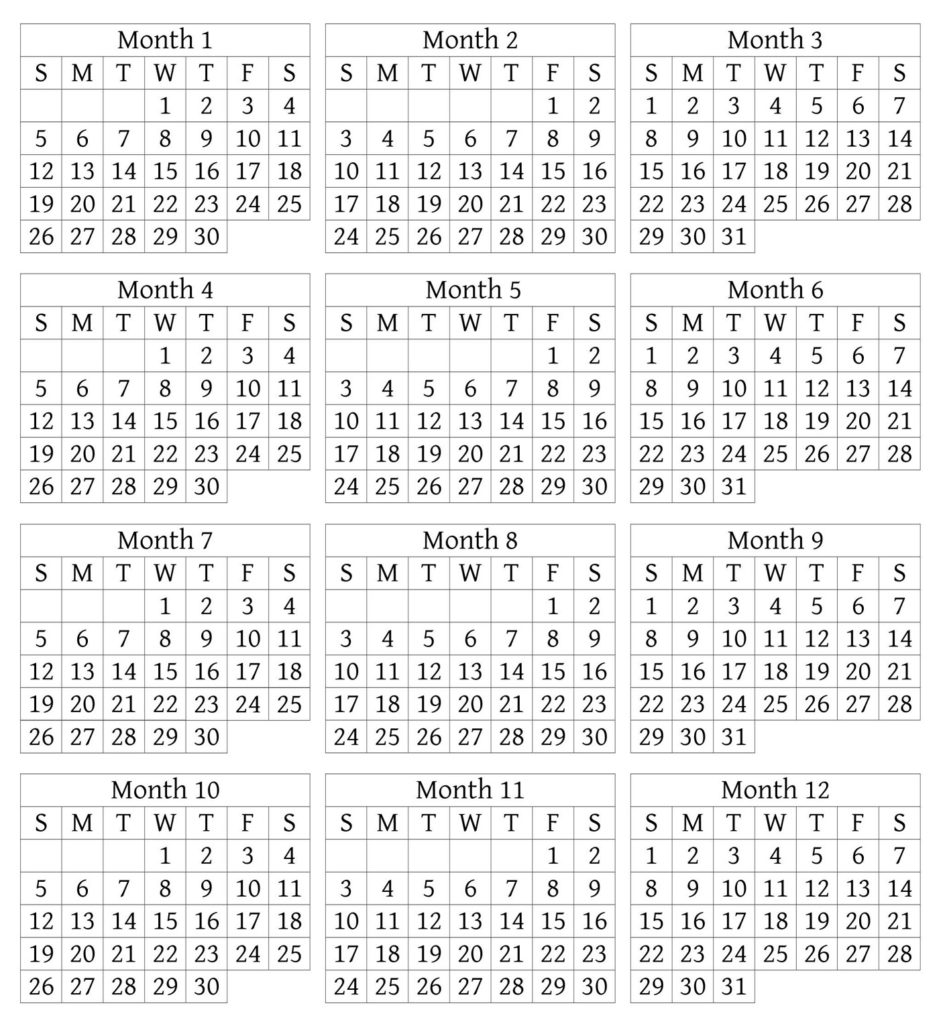
There are never more than twelve numbered months in this calendar unlike the Jewish lunar calendar which is really the pagan Babylonian lunar calendar which has to insert a 13th lunar month every so often. A lunar year is 354 or 355 days long with lunar months of 29 or 30 days. A lunar month can never be less than 29 days or more than 30 days. Since the length of the solar year is 365.24 days a lunar calendar is running faster than the solar year by 10 or 11 eleven days each year. In three years it has run faster by a whole month and thus an additional lunar month has to be added to the lunar calendar in order to slow it down so that it remains in sync with the seasons of the solar year. The bible never mentions a 13th lunar month because the biblical calendar is not a lunar calendar.
However, the 364-day calendar is moving faster than the solar year by 1.24 days each year and this means that some adjustments have to be made periodically in order to keep the 364-day calendar from slipping out of alignment with the seasons of the solar year of 364.24 days. The scriptures tell us this was done by adding weeks to the calendar during the seventh month.
When Shalamah (Solomon) dedicated the first Temple on the 15th day of the seventh month during the Feast of Tabernacles, he added a week of seven days to the feast so that the feasting lasted fourteen days (1 Kings 8:2, 65-66), but this insertion of a week did not increase the 30 numbered days of the seventh month. Rather, it put the seventh month on pause. The Feast of Tabernacles is a seven-day feast from 7/15 to 7/21. Then on the eighth day, which is the 22nd day of the seventh month, there is to be a non-feast day and a holy convocation (Thorah 3.23:33-44). Shalamah observed the seven days of the feast, then the 22nd day was a non-feast day, then seven more days for feasting were inserted into the seventh month, interrupting the seventh month, and the eighth day was the 23rd day of the seventh month (2 Chronicles 7:8-10).
In other words, the year that Shalamah dedicated the Temple was a leap year of 371 days because a week of seven days was added to the seventh month between 7/22 and 7/23, but only 364 days were reckoned to the twelve months of the calendar year. This proves that the biblical calendar is not lunar but is a schematic 364-day calendar divisible by seven with twelve months of 30 or 31 days.
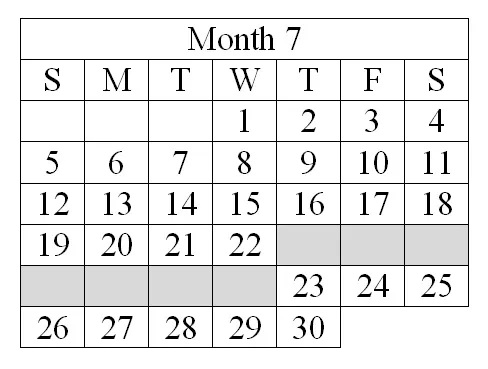
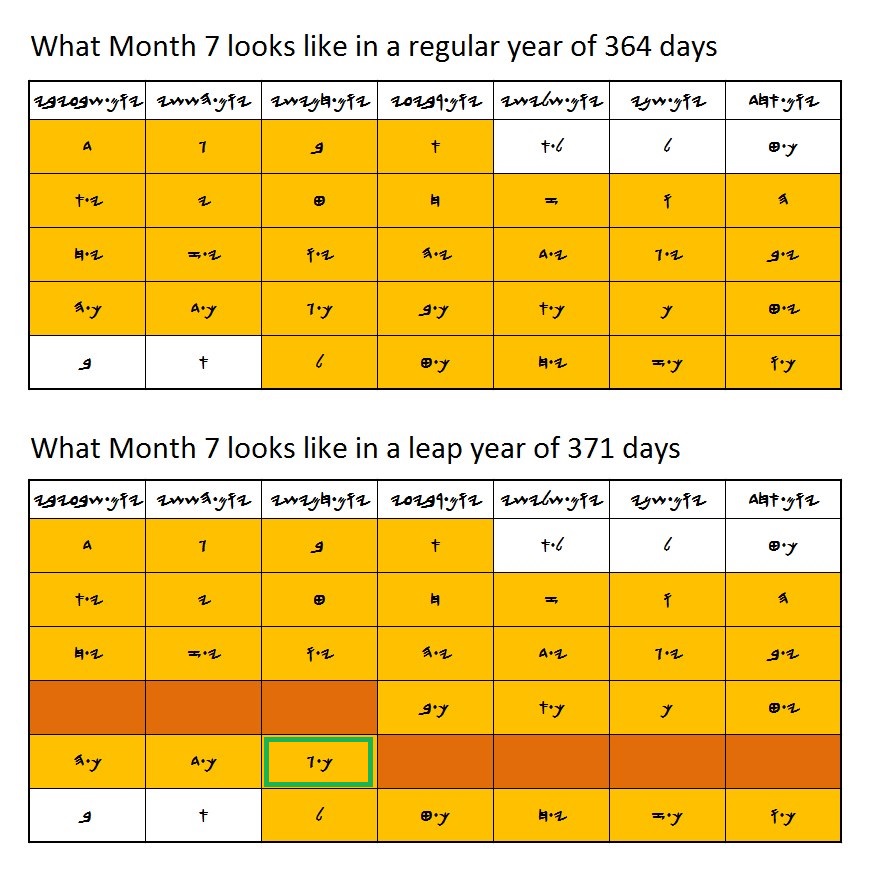
Without adjustments like this a 364-day calendar will cycle through the seasons of the solar year in 294 years and return to the same point. In order to prevent this from happening fifty two weeks (364 days) have to be added to the 364-day calendar in the course of 294 years. This means that the number of days in 294 years will be 364 x 294 + 364 = 107,380 days, and this is about the same number of days that the solar year will have in 294 years: 365.24 x 294 = 107,380.56. It means that the first day of the first month of the 364-day calendar will remain in the spring season and not drift into another season.
From the numerical data of the scriptures we can determine that the year Shalamah dedicated the Temple in the Year 4236 (994 BCE) was the first year of a seven-year week and the 22nd year of a 49-year cycle, and this establishes that weeks are added to the 364-day calendar every seven years during the seventh month of the first year of a seven-year week.
The Thorah written by Mashah provides the precise schedule for leap years because it groups years into seven x seven weeks = 49 years (Thorah 3.25:1-12), and six cycles is 294 years (49 x 6 = 294). The 50th year jubilee is always the first year of a new 49-year cycle. Thus, the leap years of the 364-day calendar are the 50th year (i.e. the first year), the eighth year, the fifteenth year, the twenty-second year, the twenty-ninth year, the thirty-sixth year, and the forty-third year within every 49-year cycle. The seventh year, the fourteenth year, the twenty-first year, the twenty-eighth year, the thirty-fifth year, the forty-second year, and the forty-nine year are all shabath years when the promised land is not to be sown nor vineyards pruned (Thorah 3.25:3-7). Weeks are not added to the calendar during the shabath years.
However, the 50th year is called the Yobal (jubilee) because the noun yobal/יובל is derived from the root yabal/יבל which means “to bring over,” “to carry over”. The 50th year Yobal is the year of the “carryover” because these six years in every 294-year cycle have more weeks carried over into them than just the one week that is added to a regular leap year. There are forty-two leap years in 294 years. Thirty-six leap years in 294 years will be 371 days (i.e. one week inserted into the seventh month between 7/22 and 7/23). Four leap years will last 378 days (i.e. two weeks inserted into the seventh month between 7/22 and 7/23) in 294 years. Two leap years will last 392 days (i.e. four weeks inserted into the seventh month between 7/22 and 7/23) in 294 years. The six years in every 294-year cycle with more than one week added to the seventh month between 7/22 and 7/23 are the 50th Yobal years. These are also the first years of a new seven-year and a new 49-year cycle. This is how 52 weeks are added to the 364-day calendar in the course of 294 years.
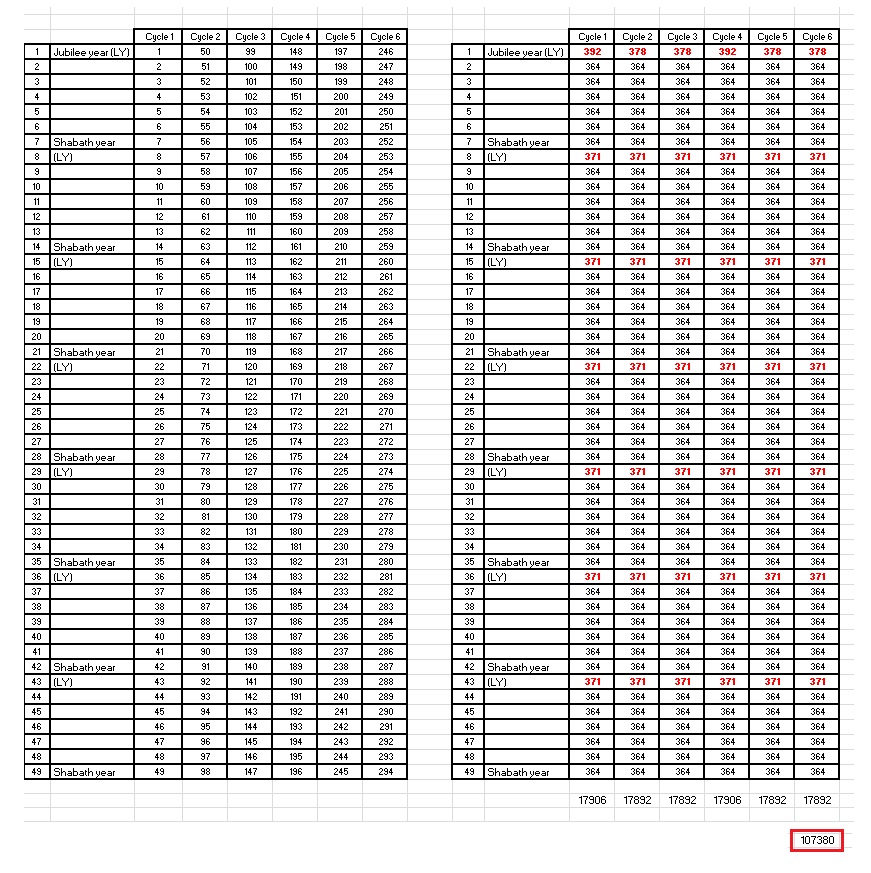
The above table is based on the very simple math from the scriptures. It allows one to track each and every day from the first day of creation when Alah’aym said: YA’AY ‘OR (Let there be light!) down to this very day in accordance with a 364-day calendar. Calendar dates can be calculated with razor precision and converted to their Julian or Gregorian equivalents.
The system of reckoning widely used by heathen astronomers in order to track days and make astronomical calculations is called Julian days. These are the number of days since noon on January 1, -4712 (4713 BCE). In the heathen’s calendar today is Tuesday, June 20, 2023 and the Julian day number is 2,460,116. In our set apart calendar today is 3.31.7252, the last day of the third month, and yom shalayshay (Day Third). The day number since the first day of creation is 2,648,446. This is twenty-four periods of 294 years (107,380 days x 294 years = 2,577,120 days) plus 71,326 days. The period of 71,326 days is 17,906 days (Cycle 1) + 17,892 days (Cycle 2) + 17,892 days (Cycle 3) + 270 days into Cycle 4, or day 94 minus the first three days of creation = day 91 of the calendar year. Day 91 of the calendar year is always yom shalayshay (Day Third) Month 3, Day 31 in the 364 day calendar. The figure 2,648,446 is 378,349 weeks (2,648,443 days) plus three days because today is the third day of the seven-day week. This is the exact number of days and weeks that have elapsed in 7,252 years from the very first day of creation down to this very day. In the heathen systems of reckoning the Julian day was -188,329 and Sunday, May 20, 5229 BCE. The set apart calendar year commenced three days later on yom rabay’ai’ay (Day Fourth), and these first days of the world were the days of the first spring equilux when daylight and nighttime were equal in duration.
This is lokh ha-yamaym (the calendar) according to the one Above All, whose name I proclaim from the east, and who made heaven and earth in six days and rested on the seventh day and set it apart.
His name is YA’OH
Always has been. Always will be.
#EXODUS2023
1.15.7252 (April 5, 2023)

Excellent info Akh`ay , this is definitely the first time I’ve ever seen or read, or heard anything like the way you have broken down the LOKH-HA-YAMAYM so-called wicked caucus mountainous man’s calendar and its flawed ways. Truly an eye-opener for sure. TOB MA`AD, SHALOM MABAYN….